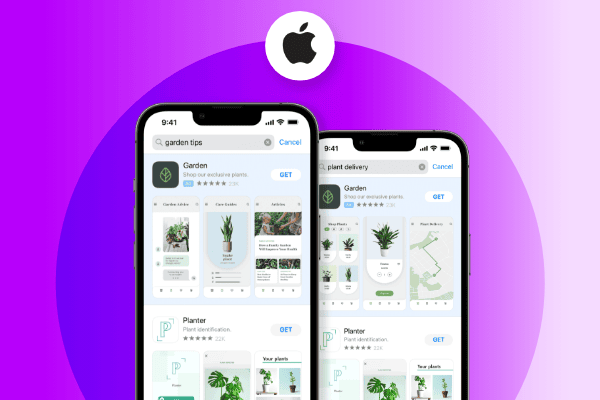Summary
Apple Search Ads’ search results ads appear at the top of App Store searches, offering high visibility and conversion rates. Advertisers can target these ads using exact or broad match keywords, and best practices include focusing on keyword relevancy and aligning ad creatives with user searches. Read the full post to learn all about this powerful app advertising opportunity.
What are Apple Search Ads search results ads?
Search results ads appear in the list of results a user is shown when searching for a specific app or type of app on the App Store. When your ad is displayed, it appears prominently at the top of the results, giving you the best chance to be seen by your audience. Because search results ads are shown when a user is intentionally searching for an application to download, they boast exceptionally high conversion rates.
When should I use search results ads?
Use the search results placement when your main goal is high quality installs. They are a great way to leverage clear search intent, getting you in front of potential users when they’re actively searching for an app like yours.
How do I target my audience?
Search results ads are targeted using keywords, which can then be broken down into exact match and broad match keywords.
Exact match keyword targeting uses search terms that precisely match ‑ including common misspellings and plurals — input by users when searching in the App Store. For example, if you are promoting a photo editing app called “Sick Pic” that takes standard selfies and overlays them with popular effects, then “Sick Pic” would be an exact match keyword you’d want to target.
Broad match is the default match type for search results ads, which is recommended for use when you are looking to test and discover new keywords. If, for example, you are targeting “photo effects” broadly, then you will also reach users that type in similar terms, misspelled versions of that keyword (just like exact match), and more. Once you’ve identified new keywords through broad match targeting, you can later add them to exact match campaigns and then test new broad match terms, and so on.
Finally, when you’ve identified keywords that are not cost-effective or do not result in installs or meet your LTV goals, you can add them to your campaigns as negative keywords to ensure your budget is only spent on terms that help you achieve your goals.
And then there’s Search Match. Search Match is a default feature of Apple Search Ads Advanced search results campaigns, allowing you to get ads up and running in minutes. With Search Match enabled, your ad will be automatically matched to search keywords, eliminating the need for you to manually identify and bid on all keyword possibilities.
Search Match employs a variety of resources to match your ad to relevant App Store searches, including metadata from your App Store listing, information about similar apps in the same genre, and additional search data. We propose running a discovery campaign with Search Match enabled to reach a larger audience and mine hot search terms. You may want to explore adding particular terms to your ad group and setting specified bids for them.
Learn more on the Apple Search Ads website.
Search results ads best practices
Focus on relevancy
Make sure the keywords you are targeting are highly relevant to your audience. Apple
Search Ads takes relevancy into consideration when deciding which ad wins the bid for placement, and no matter how high your bid is, if your ad is deemed irrelevant to the audience, it will not be placed.
Make sure your product page is on point
Having a well-optimized App Store Product Page is the best place to start, as your App Store metadata is taken into account in relevance to keywords. You wouldn’t spend on ads to get people to your website if it wasn’t great, right? Same thing here. Great Product Pages are a critical part of the success chain on the App Store.
Creative is key
Targeting the right keywords is essential, but it’s equally important that the information shown to users in search results ads—and then the product page they land on—aligns with their search. (suggestion) By setting up ad variations from your App Store custom product pages, you can ensure you match your creative to exactly what the user is searching for.
Campaign structure matters
Apple Search Ads recommends breaking campaigns into four categories:
- Brand. Campaigns featuring exact match keywords related to your app and or brand.
- Category. Campaigns featuring exact match keywords related to the category of your app (e.g. travel, productivity, entertainment).
- Competitor. Campaigns featuring exact match keywords related to your competitors.
- Discovery. Campaigns used to identify new exact match keywords for brand, category, and competitor campaigns by targeting broad match keywords and with Search Match turned on, which can then be distilled to new exact match terms through campaign analysis.
How can I do this at scale?
Apple Search Ads provides you with many capabilities to build, manage, and optimize campaigns to meet your goals and targets. However, if you find yourself or your team spending too much time manually managing and optimizing campaigns, or if you’re running campaigns through additional publishers, it’s likely time to begin searching for a marketing platform partner.
As an Apple Search Ads Partner, Skai injects additional power into your Apple Search Ads campaigns through our industry-leading technology. In addition to the capabilities provided on the native Apple Search Ads platform, Skai supports bulk campaign creation, management, and editing, as well as automated reporting, multiple optimization strategies, and more. Skai also offers the ability to run mobile app campaigns across TikTok, Snap, and GAC alongside paid search, paid social, and retail media initiatives with centralized data and key takeaways that can be directly implemented across them all.
More like this
Want to be a part of The Breakthrough?
Tell us your omnichannel thoughts and join the voices on The Breakthrough







